This picture shows two images of Europa taken by the Galileo spacecraft. One taken in natural light (to the left), and the other with colors enhanced by computer.
Click on image for full size
NASA
Europa
Europa was first discovered by
Galileo in 1610, making it one of the
Galilean Satellites. It is Jupiter's 4th largest moon, 670,900 km ( miles) from Jupiter. Europa's diameter is about half the distance across the United States, 3138 km (1950 miles), and is close to the same size as the
Earth's moon (click
here to learn more about Earth's Moon and Europa).
Europa is named after one of
Jupiter's many girlfriends from
Greek mythology. The
Galileo spacecraft discovered that there may be an
ocean under its icy surface! The last time an ocean was discovered was the Pacific Ocean, 500 years ago. This means Europa is one of the few
moons in the solar system that may have liquid water, which scientists think is friendly to
life. The
surface has many neat features, even though it is mainly made of
ice. Europa also has a very thin
atmosphere.
You might also be interested in:
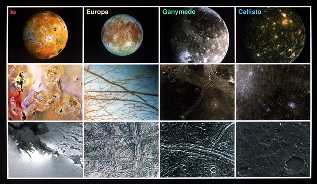
The Galilean satellites are the 4 big moons of Jupiter, Io, Europa, Ganymede, and Callisto. These moons are called Galilean because they were discovered by Galileo Galilei in 1610. In this picture, Io,
...more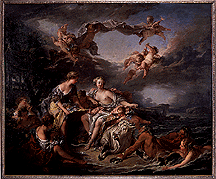
Europa was a beautiful princess. According to Greek mythology, Europa was seduced by Zeus, the king of the gods. Zeus fell in love with Europa after seeing her gathering flowers by the sea. Zeus changed
...more
Galileo was a spacecraft that orbited Jupiter for eight years. It made many discoveries about Jupiter and its moons. Galileo was launched in 1989, and reached Jupiter in 1995. The spacecraft had two parts.
...more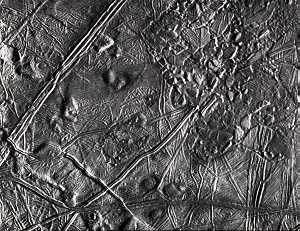
The surface of Europa shows many signs of that there may be an ocean hidden underneath: * flooded areas * 'freckles' * 'rafting' * 'mushy' craters, and * regions of spreading. These clues make it pretty
...more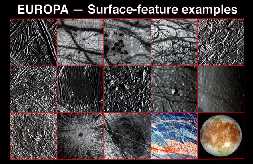
Many exciting discoveries were made about Europa during the Galileo mission. The surface of Europa is unusual, even for an icy moon. It appears that the surface is pretty new, rather than being ancient.
...more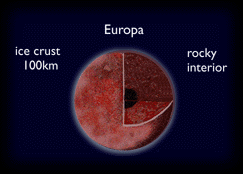
The diagram to the left shows the possible interior of Europa. The composition of the icy moons is mostly ice, therefore there is probably a small core of rocky material buried inside, covered with ice.
...more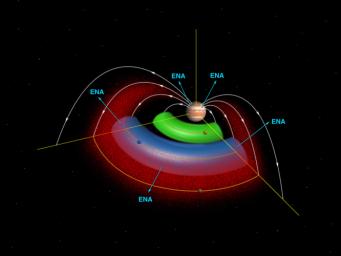
The Galileo mission discovered an amazing thing! Europa has its own atmosphere, although it is very, very thin. When fast moving molecules traveling through space near Jupiter hit Europa's atmosphere,
...more















